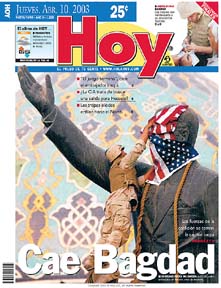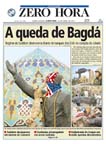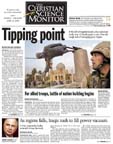
Newspaper Coverage of the War in Iraq

On March 19, 2003, President George W. Bush of the United States announced that a coalition of countries has begun a mission to "to disarm Iraq, to free its people and to defend the world from grave danger." Following a cruise missile assassination attempt on Iraqi president Saddam Hussein, a massive bombing campaign was conducted to 'shock and awe' the Iraqis, and this was soon followed by the injection of ground military forces.
Much more so than the predecessor known as Gulf War I, this war was covered intensely by media all over the world. Television coverage was available 24 hours a day on many different television channels such as Al Jazeera, BBC, CNN, MSNBC, Fox News, etc. In the following, we show the front page covers of a number of newspapers from various countries during the first few days of the war (note: click on the thumbnail to read the large image). There is a certain sameness in the coverage from different countries, at least insofar as the photos are concerned (namely, Baghdat being bombed and coalition troops on the move), but the headlines are in fact sometimes starkly different (e.g. Iraq War Begins in the Boston Globe versus EUA começam ocupar o Iraque in Zero Hora).
Three weeks into the war, the coalition forces reached the capital city of Baghdad. In the following, we show the newspaper front pages from a number of countries. Again, there is a certain sameness in the coverage when seen from afar, especially in choosing one of two photos for the front covers. However, that choice in fact a litmus test of political correctness. One photo has a US marine draping the American flag over the face of a statue of Saddam Hussein. The flag was later ordered to be removed by US military commanders, since they wanted to communicate that this was a war of liberation ("Operation Iraqi Freedom") and not an imperialistic conquest. Now, this particular photo did not appear in the front pages of the major US newspapers (Christian Science Monitor, New York Times, El Nuevo Herald, USA TODAY, Washington Post) even though its appearance may be mentioned in news stories inside the newspapers. The photo did appear in many Latin American newspapers, sometimes with unsparing headlines (Bagdá conquistada and Se impone la fuerza).
 Zero Hora |
 Jornal da Tarde |
 O Estado de S. Paulo |
 O Globo |
 El Colombiano |
 El Imparcial |
 El Universal |
 Christian Science Monitor |
 Hoy |
 New York Times |
 El Nuevo Herald |
 USA TODAY |
 Washington Post |
 El Universal |
A sideshow in this war is the roles that the various media played, particularly with respect to the alleged subservience of news coverage to political or corporate goals. There is enough material for many books to be written some day. The New York Times published an article titled: Telling War's Deadly Story at Just Enough Distance
In the darkness of a conference room at Time magazine last Friday, a war of terrible and beautiful images unfurled on a screen: the steely-eyed marine taking aim, the awe-struck Iraqi pointing to bombers in the sky, the bloodied head of a dead Iraqi with an American soldier standing tall in the background.
The last image was an appalling but vivid representation of American dominance in a very violent week. But Stephen J. Koepp, deputy managing editor of Time, dismissed the photograph as a candidate for the issue to be published today. "You want a little picture with your blood," Mr. Koepp said. The photo and editorial staff assembled in the half-light murmured in agreement.
Large numbers of Iraqi soldiers have been killed, according to the Pentagon, and more than 2,000 Iraqi civilians, the government of Saddam Hussein said, many of them in the last week. But when James Kelly, the managing editor of Time, lays out the 20 pages of photos intended to anchor the magazine's coverage of the war, there were pictures of soldiers, battles and rubble, but no corpses.
The squeamishness about the carnage that is war's chief byproduct is not restricted to Time magazine. During an era when popular culture is filled with depictions of violence and death, and the combination of technology and battlefield access for reporters has put the public in the middle of a shooting war, the images that many Americans are seeing are remarkably bloodless. The heroic narrative is shaped in part by what editors and producers view as a need to maintain standards and not offend their audience. But some cultural critics say that the relatively softened imagery has more to do with a political need to celebrate victory without dwelling on its price. If this is war, they ask, where is the gore?
"War is about dead people, not gorgeous-looking soldiers," said Susan Sontag, author of "Regarding the Pain of Others." She suggested, "Being a spectator of calamities taking place in another country is a quintessentially modern experience."
...
Mr. Kelly of Time is in the midst of wondering about similar things. As a way to communicate the costs of the war, he chose a photograph of an Iraqi boy being tended to by his aunt who had been severely burned in a firefight near Baghdad, in addition to losing both his arms and his family.
"You don't want to give the reader a sanitized war, but there has to be some judgment and taste," he said.
Ms. Sontag wondered whom such standards actually protect. "The friends I have all over the world are seeing horrifying images of what is happening when those bombs drop," she said. "I am always suspicious when institutions talk about good taste. Taste belongs to individuals."
John Gaps III, photography director of The Des Moines Register, agreed to a point. "Any time you start applying the word `taste' to war, you minimize and trivialize what is happening on the battlefield," said Mr. Gaps, a former Associated Press combat photographer.
Arab news executives said their Western counterparts were misleading viewers and readers by showing a war without death and pain.
"What happens in Iraq is not covered honestly on CNN, BBC," an Al Jazeera news executive said in a telephone interview from Doha, Qatar. "We don't see any of those killed by the American forces." It also explains, he said, why the rest of the world feels so differently about this war than most Americans do.
A Salon.com article titled Sanitized For Our Protection begins with this question: " The rest of the world is shown far more graphic war images than the U.S. media allows. Is the American public being insulated from the true horrors of the battlefield?"
The images of cheering Iraqis celebrating the demise of Saddam Hussein and dragging a demolished statue of the dictator through the streets of a liberated Baghdad will be linked forever with this war. It was the sort of defining moment that American media outlets have thirsted for, a feel-good picture of a coalition-led victory that could be played and replayed.
But the war is not yet over, and more fighting and attacks are certain, as painfully proved by Thursday's suicide bombing at a U.S. checkpoint in Baghdad. Once the thrill of the falling statue fades, news outlets will again be confronted with the grisly reality of grave injury and death -- among U.S. soldiers, Iraqi soldiers and civilians. But if the past three weeks are any guide, the American news media will not run them. And as a result, American news consumers will have little idea of what happens when the world's mightiest military power unleashes sustained attacks, albeit targeted ones, on an impoverished, despot-ruled nation, or what happens when that regime, fighting for its life, answers in kind.
To be sure, there have been deeply troubling pictures, but sometimes even they have a sentimental overlay. Perhaps the most famous battlefield photo to date, one that ran on newspaper front pages across the country, is a haunting shot of an Army doctor in full military gear squatting on the dirt and holding a young Iraqi girl in his arms just minutes after her mother had been killed in crossfire. The New York Times, Time magazine, CNN.com and others have, occasionally, run photos that featured more jarring looks at the injured and dead.
But those are exceptions.
In the book Regarding The Pain Of Others, Susan Sontag identifies a certain cynicism about images of atrocity: "It has become a cliché of the cosmopolitan discussion of images of atrocity to assume that they have little effect, and that there is something innately cynical about their diffusion. As important as people now believe images of war to be this does not dispel the suspicion that lingers about the interest in these images, and the intentions of those who produce them ... Citizens of modernity, consumers of violence as spectacle, adepts of proximity without risk, are schooled to be cynical about the possibility of sincerity. Some people will do anything to keep themselves from being moved. How much easier, from one's chair, far from danger, to claim the position of superiority." If we move beyond this type of defensive cynicism, what questions should we be asking?
The book jacket to Sontag's book begins with: "One of the distinguishing features of modern life is that it supplies countless opportunities for regarding (at a distance, through the medium of photography) horror taking place throughout the world. Images of atrocities have become, via the little screens of the television and the computer, something of a commonplace. But are viewers inured --- or incited --- to violence by the depiction of cruelty? Is the viewer's perception of reality eroded by the daily barrage of such images? What does it mean to care about the suffering of people in faraway zones of conflict?"
These are fairly abstract theoretical questions, but they can be tested immediately. While the mainstream media may have practiced self-censorship to suppress the most brutal images of wartime horror, this war is different from Gulf War 1 in that the most interesting information and insightful analyses come from numerous independent internet sources ("the war bloggers"). For anyone who takes the time to look around the Internet, many images of war can be found. We have compiled of a collage of such images (WARNING: EXTREME VIOLENCE) here. Look at them and see if you would agree with this statement in Sontag's book: "... if the horror could be made vivid enough, most people would finally take in the outrageousness, the insanity of war"?
(posted by Roland Soong, 4/11/2003)
(Return to Zona Latina's Home Page)